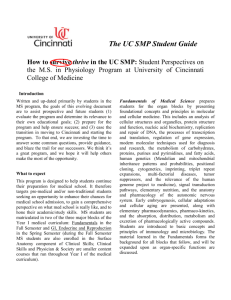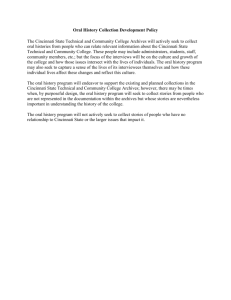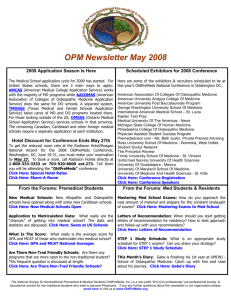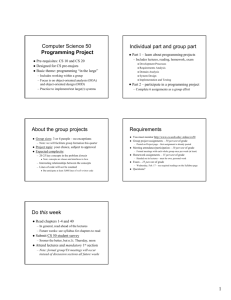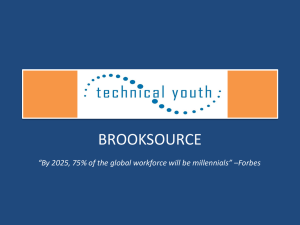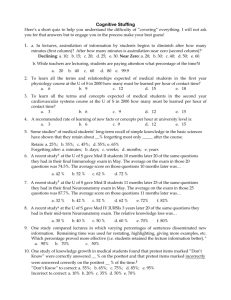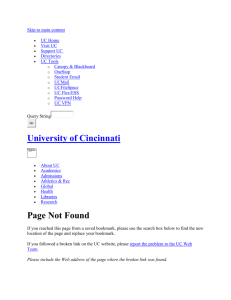The Survival Guide Student Perspectives on the M.S. in Physiology
advertisement
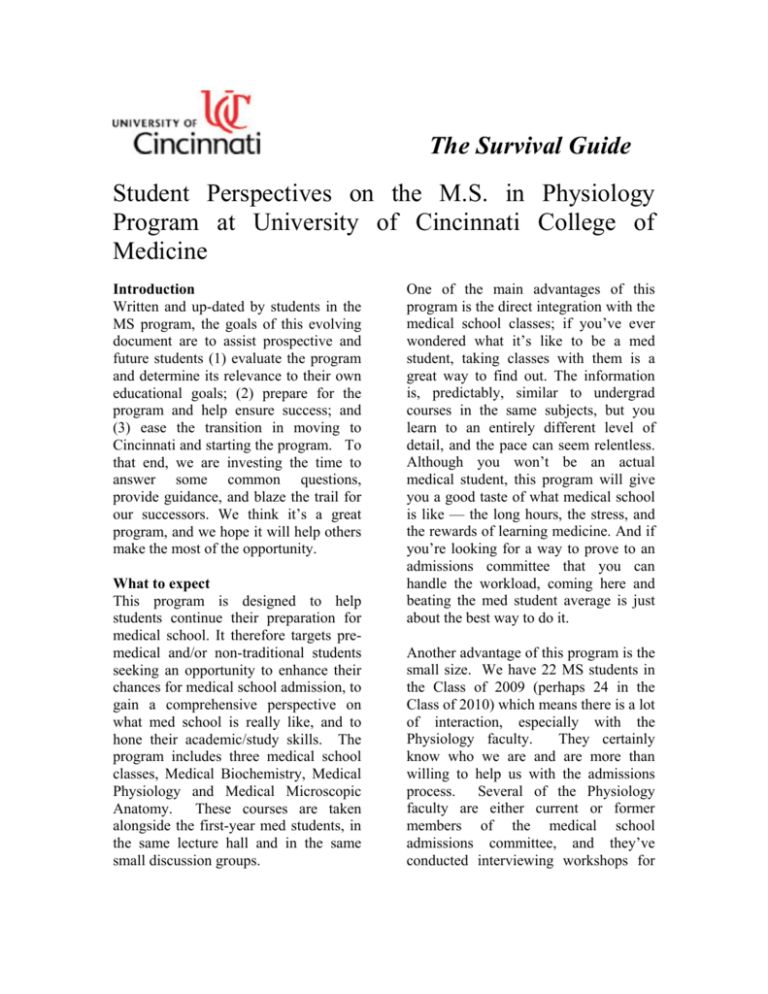
The Survival Guide Student Perspectives on the M.S. in Physiology Program at University of Cincinnati College of Medicine Introduction Written and up-dated by students in the MS program, the goals of this evolving document are to assist prospective and future students (1) evaluate the program and determine its relevance to their own educational goals; (2) prepare for the program and help ensure success; and (3) ease the transition in moving to Cincinnati and starting the program. To that end, we are investing the time to answer some common questions, provide guidance, and blaze the trail for our successors. We think it’s a great program, and we hope it will help others make the most of the opportunity. What to expect This program is designed to help students continue their preparation for medical school. It therefore targets premedical and/or non-traditional students seeking an opportunity to enhance their chances for medical school admission, to gain a comprehensive perspective on what med school is really like, and to hone their academic/study skills. The program includes three medical school classes, Medical Biochemistry, Medical Physiology and Medical Microscopic Anatomy. These courses are taken alongside the first-year med students, in the same lecture hall and in the same small discussion groups. One of the main advantages of this program is the direct integration with the medical school classes; if you’ve ever wondered what it’s like to be a med student, taking classes with them is a great way to find out. The information is, predictably, similar to undergrad courses in the same subjects, but you learn to an entirely different level of detail, and the pace can seem relentless. Although you won’t be an actual medical student, this program will give you a good taste of what medical school is like — the long hours, the stress, and the rewards of learning medicine. And if you’re looking for a way to prove to an admissions committee that you can handle the workload, coming here and beating the med student average is just about the best way to do it. Another advantage of this program is the small size. We have 22 MS students in the Class of 2009 (perhaps 24 in the Class of 2010) which means there is a lot of interaction, especially with the Physiology faculty. They certainly know who we are and are more than willing to help us with the admissions process. Several of the Physiology faculty are either current or former members of the medical school admissions committee, and they’ve conducted interviewing workshops for us, etc. It’s a clear advantage over many other masters’ programs. Preparation for the program Being prepared is important since you will need to “hit the ground running” on the very first day of class. The fall quarter has proven to be the most difficult and important, due to the increased difficulty of the med school classes and the need for your best performance in order to supplement your applications with your current grades (if you choose to apply to med school while in the program). In most cases students will already have the MCAT behind them, and this is highly recommended. If you decide to take the MCAT after classes have started, be aware there will be very little time to study. Adjusting to the new city, school, and atmosphere is not a very conducive time to be preparing for the MCAT. If you must take the MCAT after classes start, it is possible (a few students do this and most), but don’t plan on it if you can help it. If you are planning on applying to medical school while in the program, you should make every effort to have your AMCAS and secondary applications complete and submitted before classes start. Just like trying to study for the MCAT, there will not be a great deal of time available to write application essays. Also once classes start, you will want to obtain a “letter of intent” from Dr. Banks. This is basically a letter summarizing the program. You should send this letter out to all of the medical schools for which you complete secondaries. This will let schools know to be looking out for grades, update letters, and exactly what the program entails. For the purposes of financial aid, students in the program are not considered medical students, even though they begin at the same time as the medical students do. Therefore, according to federal regulation, financial aid can’t be distributed until the rest of the University is in session. This usually is in the first week of September. This means that student loan reimbursements, as well as tuition, will not be distributed/due until about one month after classes start. Although you will not be required to pay tuition until that time, you will not have any loan money available to help pay for rent, utilities, bills, etc. Thus, you should plan ahead and save so that you will be able to cover these costs. Tuition will be due at the beginning of each of the four quarters and a bill summary can be found on the University’s Onestop website (onestop.uc.edu.). Finally, as was mentioned above, classes start off fast and reach a grueling pace within a week or two, which makes it very easy to get behind from the start. Therefore, it is to your advantage to get settled in and have all the small details in order as best as possible prior to the start of classes. What classes are like Classes at UC are somewhat irregularly scheduled. The curriculum was redesigned a few years ago to coordinate organ systems; when you’re learning about the heart, you’d be dissecting it in Gross Anatomy, learning about its development in Embryology, studying its function in Physiology. For the med students, this translates into a roughly 95 day, every day. Since you are seeing only part of the curriculum, the MS schedule is somewhat variable. Some days may only have a couple of hours of class where others may have 4 or more hours of class, and possibly a seminar or other event. As one might guess, time management and organizational skills are necessary to keep up with the material. Med ClassesBiochemistry, Physiology, Microanatomy These classes are the main focus of the curriculum and last throughout the fall and winter quarters. Physiology and Microanatomy finish up at the end of February while Biochemistry will end right before Spring Break (middle of March). You will have a break from Biochemistry from after Christmas break until the end of February. The lectures for these classes are generally PowerPoint presentations and are posted to Blackboard (Internet-based tool that UC uses) either before or right after the lecture. Also audio recordings for all lectures are available in mp3 format on Blackboard following the lecture. Because all the PowerPoint files and recordings are posted to Blackboard, catching up on a missed lecture is fairly easy. Nevertheless, most students attend the lectures; it’s easier to know what they’re pointing at on screen with the laser pointer, which you may not get listening later. Exams are every 4-6 weeks and there are also weekly quizzes in the Physiology and Biochemistry small groups. Each small group has around 6 or 7 medical students, 2 MS students, and a group leader (a 2nd year med student). Each small group session consists of a quiz followed by a discussion session revolving around a problem set that is distributed beforehand. These sessions help to keep you caught up with the material and are a good way to judge your progress. Exams are multiple choice, but they are very difficult (the notorious all of the above, some of the above, and none of the above answer choices). Also all exams are closed, which means that you don’t get your graded exam to take home and review. You can however, make an appointment to look at your test. This is highly recommended for biochemistry, since there will a cumulative final at the end of the course. When it comes time for tests, the “Internal Medicine CD files” will become quite useful to you. These files can be downloaded from Blackboard and have old tests, study guides, and quizzes. While the old tests may not resemble your tests 100%, they are very helpful at gauging your progress. Usually at least a few questions show up on the actual test that are very similar to the practice tests. Biochemistry- This course is directed by Dr. Lieberman and is based almost solely on the PowerPoint presentations and content of the lectures. There are several recommended texts which were helpful to clarify certain concepts, but most students do not use them for primary resources. If you choose not to buy any of these books, they are all on reserve at the library. The textbook, along with some others that have been found helpful are: Smith, Marks, Lieberman. Mark’s Basic Medical Biochemistry: A Clinical Approach (2nd Ed.), Lippincott, Williams & Wilkins, 2004. ISBN: 0781721458. Make sure you buy this one and NOT Mark’s Essential Medical Biochemistry! Marks. Biochemistry: Board Review Series (3rd Ed.), Lippincott, Williams, & Wilkins, 1998. ISBN: 0683304917. The many copies of this seem to indicate its popularity. Voet & Voet. Biochemistry (3rd Ed.). A big, heavy, expensive one, but more detailed than any other. It can be useful for some discussion group questions for which answers are in no other book. Champe, Harvey, Ferrier. Lippincott’s Illustrated Reviews, Biochemistry (3rd Ed.). Useful if you’re a visual learner (i.e. a diagram is better than words). Microanatomy-This course is directed by Dr. DJ Lowrie and is based around PowerPoint lecture files and a syllabus that is distributed during orientation. This is the best resource for the lecture portion of this course. This course also has a significant lab component. You will be required to view and identify histological slides of tissues using a microscope and digital slides that are available on Blackboard. Most of us found this to be the most difficult part of the course and found supplemental texts to be very useful. For light microscopy slides helpful resources include, Wheater’s Atlas and Text and Netter’s Microanatomy Atlas. For electron micrograph images the previous books have some images, but the best resource is a book by Rhodan that is on reserve in the library. Also on the internal medicine CD, there are Boggus review PowerPoints. These were composed by a previous medical student and are a great review prior to tests. Basically it is best to see as many images as possible prior to taking the lab portions of the tests. Physiology- This course is directed by Dr. Banks and is based around PowerPoint lectures and a very in depth syllabus. The syllabus is incredibly detailed and is sufficient as a text. This course is divided up into sections (renal, respiratory, GI, etc) and each professor will lecture on their specialty. If you find yourself struggling with one particular section, each professor recommends supplemental texts specific to their section. The 1200 page syllabus is distributed along with a CD containing an electronic copy of the syllabus, previous exam questions, old tests, and old quizzes. The best way to prepare for exams in this course (after learning the material) is to work through all the old tests and questions. Other Courses These are graduate courses and they are taught in the spring quarter, except for embryology. Embryology is taught during the winter quarter. The graduate classes are small and consist of your fellow classmates along with a few other graduate students. Clinical Embryology- This is an online course created by Dr. Lowrie. This class consists of virtual lectures, three exams, and a final cumulative exam. Handouts are provided for this class, but the tests focus mostly on the lectures and PowerPoint files. Molecular Physiology- This class is focused on the structure and function of ion pumps and channels as well as the diseases that result when they become dysfunctional. The disease portion of the course is presented by the students. At the beginning of the quarter, each student selects a disease and prepares a 20-30 minute presentation. Each presentation is given following the faculty member’s lecture on the corresponding topic. All material for the course is in the form of research articles provided by the instructors. The presentation is worth half of your course grade and the other half is from a final exam at the end of the quarter. Statistics- This course involves lectures on the theory and practical use of statistic analyses in scientific research as well as computer workshops. The workshops utilize sample data sets to better illustrate when to use specific tests and how to utilize statistical software. The material for the course is mostly in the form of lecture slides and handouts, although a modern, easy-to-read text is available for supplementation. The optional recommended textbook is: Rowe, Philip. (2007) Essential Statistics for the Pharmaceutical Sciences. A more brief statistics text is also available: Wiley, Chichester. Nononsense Statistics. Neurophysiology- This course is a hybrid between a medical and a graduate class in terms of format. The lectures go rather quickly and cover a large amount of material. The textbook for the course is easy to read and has good figures. The lectures follow very closely with the text and use many of the same figures. There are 2 exams, one for each half of the course. Each exam is multiplechoice and is similar in format to the med school exams. There is also an optional comprehensive final exam which you can take to try and improve your grade at the end of the course. Thesis The literature review paper is a very important in that it accounts for a large portion of your overall GPA for the program. Thus, completing the review paper to the best of your ability is crucial to help ensure you complete the program and earn a Master of Science degree. An extensive list of advisors and topics is distributed during orientation and each student will need to select and an advisor and a topic in which they are interested. Most students select to do a literature review, while some students select to do a traditional research based thesis. The majority of the work on your review paper will be in the spring and summer, but getting started early is highly recommended. During the first few weeks of school, you will need to select a topic and a faculty advisor. When selecting a topic, it is most important to choose a topic in which you are interested. Each topic has many different aspects which allow you to focus on an area that interests you. It is also important to select a faculty member with whom you will be able to work well with. Some faculty members will provide a very structured approach while others tend to allow the student to take their own approach. Throughout the first two quarters you will need to begin reading articles and meeting with your advisor. An outline will be due at the beginning of winter quarter, so you will need to be familiar with your topic by this time. Additionally, your faculty mentor may also be asked to contribute to your letter(s) of recommendation that Dr. Banks will send out to the medical schools you’re applying to, so getting to know your mentor early is clearly an advantage to you. One recommended strategy is to try and meet with your mentor once a week to discuss a paper(s) you have read, to ask questions, and just to get to know them. The process of writing the review paper is long and can be difficult. You will have to read many, many articles in order to simply understand all of the background information on your topic. From there you will have to read more articles to understand the research techniques, more articles to provide support or opposition to hypotheses and ideas, more articles to show where the current research is headed, and more articles to allow you to make your own conclusions and hypotheses on the subject. Writing the initial draft is one of the hardest parts and can take several months. Once you have a good draft, complete with figures and references, you will need to have other students and faculty members read it and give you feedback. Revising and editing can also take a long time; you may have to read more papers and possibly re-work some of your ideas and conclusions. The entire process requires a lot of effort and can certainly be frustrating, but it is not impossible. The best advice is to start early and plan on working on your review paper throughout the entire year. This will help you in several ways. One, by starting early, you will avoid the stress of meeting deadlines. Second, reading up on your subject early on will give you the knowledge to attend seminars and guest speakers that may come to present on your topic. There are a lot of high profile researchers from around the country who come to UC to give presentations, and odds are that you may have read some of their work in your research. Being able to talk with them about their ideas and asking them questions can be incredibly helpful. Finally, writing your review paper is a process of self-education and can be a great supplement to the didactic courses you will take. The amount of research you do should make you almost an expert in some fields, which can incredibly helpful when you encounter the same material a month or two later in one of your classes. Similarly, everything you learn in class throughout the year will help you write your review paper. MSP Courses- These courses have mandatory attendance, are pass fail, and require no outside work. These classes are held on a weekly basis. Seminar continues throughout the year, while Careers only lasts for the fall quarter. Physiology Seminar- This is a weekly seminar put on by faculty from UC or visiting professors. Basically a professor will present their current research and then open the floor up for questions. These can be quite helpful, especially when the topic overlaps with your thesis topic. Careers- Each week a different person from the medical community gives a presentation on their role in medicine. Speakers that we had included an epidemiologist, a genetic counselor, and a practicing DO physician. These presentations help you to understand all the components that make up the “medical team.” Clinical shadowing The clinical shadowing program takes students into physicians’ offices in multiple disciplines, for 4 hour shifts. It allows you to observe, one-on-one, a doctor’s daily activities. Many of us have done such things in the past, but this program will give 20-30 hours with each of 3-5 different doctors in different specialties. While it is probably best to put this opportunity off until the spring (when you have more time), it is a great opportunity to build clinical experience. Other learning opportunities The biggest advantage of a program of this sort is that you gain access to a college of medicine. One of our classmates made a contact with the chair of cardiothoracic surgery, and secured an open invitation for our class to the weekly teaching lectures in that department. A couple of students have been able to scrub in and observe surgeries with that department. Others are working in the emergency and radiology departments. There are many medical and civic volunteer opportunities both close to the University and across the city. Here’s a list of a few: Cincinnati Children’s- A world-renowned pediatric hospital that is ranked within the top five nationally. They will require a TB vaccination, two reference contacts, an application form, and a steady commitment (for students that is approximately 40 hours per year). More information can be found at: http://www.cincinnatichildrens.org/give/ volunteer/. University Hospital- The main teaching hospital for the University Of Cincinnati College of Medicine. There are numerous opportunities here, and several current students have set up shadowing, work, and/or volunteer opportunities in the emergency medicine, cardiothoracic surgery, and radiology departments. One City- This is an umbrella organization for many volunteer opportunities in Cincinnati that provide assistance and outreach for tutoring children, assisting the homeless, employment training, and provides a health clinic for those discharged from hospital services but are not able to receive follow-up recovery care. Upon registering with them they will email or call you with volunteer opportunities that they need staff for. You may choose as many or as few as you like. This program is popular among some of the medical students because there is not a set schedule and events are often on the weekends. More information can be found here: http://www.onecity.org. The National Underground Railroad Freedom Center is a dynamic center and satellite of the Smithsonian Institution located in downtown Cincinnati on the banks of the Ohio River. In addition to their powerful exhibits on the history and continued presence of slavery, they frequently hold many outreach activities that require volunteer help. If you are involved with the exhibit aspect of the Center they may need you more regularly, but if you are involved with events only, there may be more flexibility in scheduling. More information can be found here: http://www.freedomcenter.org/volunteeri ng-at-the-freedomcenter/volunteering.html. That’s just the tip of the iceberg. Cincinnati.com is a website that features things to do in Cincinnati and also has a diverse list of volunteer opportunities: http://shopatcincinnati.com/volunteer/op pselect.asp Does it work? Like every program, you get out of it what you put in, and if you do well, it will help with admissions. It won’t get you in on its own, but if you combine it with good qualifications before coming, excellent results are possible. Student Acceptances As of early 2009, graduates (and current students) have been accepted into a number of different schools, including the following: Albany Medical College Arizona College of Osteopathic Medicine of Midwestern University Case Western Reserve University, College of Medicine Eastern Virginia Medical School Lake Erie College of Osteopathic Medicine New York Medical College New York University College of Dentistry NOVA Southeastern College of Osteopathic Medicine Ohio University College of Osteopathic Medicine Philadelphia College of Osteopathic Medicine-GA Pikeville College, School of Osteopathic Medicine The Ohio State School of Medicine Touro College of Osteopathic Medicine Tulane University School of Medicine Uniformed Services (The F. Edward Hébert School of Medicine) University of Calgary - Faculty of Medicine University of Cincinnati College of Medicine University of Kentucky College of Medicine University of New England College of Osteopathic University of Toledo School of Medicine Study Spots Several of us have found a variety of places to study around the University and Cincinnati. These include: Graduate student room -An old lab in the department has been designated as study space for students in program. Each of us has our own desk for studying along with storage lockers and some comfy chairs for relaxing. College of Medicine- There is abundant study space throughout the medical school building and with your student ID you have access to it 24/7. Panera Bread Company - Two locations, one on Calhoun Street on the south side of West campus and another in the Hyde Park Plaza. Free refills on coffee, enough said. The Coffee Shop on Madison- Located in the “square” of O’Bryonville on Madison Road. It just opened this past spring, has some great coffee blends and really comfy chairs. Awakenings- Located in the Hyde Park Square. Good coffee blends, espresso bar, plus art, music, and wine tastings (Not recommended while studying). Open late on the weekends. Parking can be tricky. Starbucks -There are several around, one in the hospital, one on McMillan Street south of West campus, and a new one opening next to Awakenings. IHOP/Waffle House -Good, cheap, late night eats. Can be a lifesaver during exam week. Housing Most students live in the Clifton, Ludlow area and walk to class everyday or live farther away in Hyde Park (about a 10 minute drive) and drive into school. There is a parking deck attached to the medical school building and you can buy a parking pass from the University. Also there is a great bus system around the campus and the city. As students, we get free bus passes so finding somewhere on a bus route can also be very convenient. If you can come out to visit and look at some apartments before school starts. Simply looking at apartments online can be somewhat deceiving compared to looking at the in person. Recreation The University of Cincinnati has an incredible Recreation Center, that was just recently constructed. There are several basketball courts, racquetball courts, a climbing wall, indoor track, very spacious free-weight and cardio areas, and a swimming pool with whirlpool. Also there is a brand new gym in the basement of the medical school building. Check out their website at http://www.uc.edu/reccenter/. There are quite a few things to do in Cincinnati, from pro sports teams (the Bengals and Reds) plus UC and OSU in college sports. There is a pretty good zoo along with the aquarium in Kentucky. The Air Force Museum in Dayton (~40 miles away) is huge and impressive. The Kings Island amusement park is just outside the city, and Cedar Point (“one of the best amusement parks in the world” according to one of our classmates) is 34 hours away. A group of us recently went ice skating at Fountain Square (Cincinnati’s version of Rockefeller Plaza). As far as restaurants and nightlife, some highlights mentioned by our class: The Hofbrauhaus (“1 of only 3 in the world, great Dunkel, get a DD before embarking and bring your table dancing shoes”) The Newport Levee “with a ton of fun bars (Bar Louie amongst others)” Mount Adams is “a super cool place to go and hang out. There are a lot of super trendy restaurants and very nice houses with a great lookout of the city.” Mount Airy “has a number of really nice (very unpopulated, except for the deer) hiking trails for a study break.” My two cents’ worth This section will feature candid comments from individuals in the class. Here’s the first, and more will appear in later editions of The Survival Guide. I think this program has a lot of positives that I hadn’t anticipated: 1. The small class size — we really get to know one another and we are integrated very well with the medical students. 2. The medical students here — the overwhelming majority are very supportive and friendly. I would say I have not experienced any negativity from them and if anything have made good friendships and gotten great perspectives from several. 3. The faculty — I was surprised how every lecturer reminds us constantly of their open door policy; some even give us their home phone number! The point is they give us multiple ways to contact them and remind us not to hesitate if we need help with concepts we may be struggling with. 4. The opportunities from the hospital — the cardiothoracic surgery department has kind of adopted us! We are allowed to attend their weekly cardiothoracic conferences which include journal reviews, case reviews, or lectures on specific types of imaging and procedures. It is a great place to try out your new physiology knowledge, and indeed, one of the thoracic surgeons makes it a point to question us on what we’ve learned that week! We have also been invited to shadow cardiothoracic surgeries and tour their research laboratories. I have been amazed and honored to be a part of this experience. 5. The research opportunity — you are working one-on-one with a faculty member on a research topic chosen from a list at the beginning of the year. Although the bulk of this will be during the spring and summer quarters, early and intense work early has facilitated some of the students networking with other researchers, and getting clinical, lab-based, and conference invitations. That said, I also have some recommendations: 1. Start strong, stay strong. Even if you have had biochemistry and physiology before, you will study this in a new (i.e. all clinically-oriented) and intense way. You will need to study the syllabus several times over, and do every old/practice quiz or test that comes your way. Go over your questions carefully and try to think about the material from every angle possible. 2. Try to visit here before you move. There are dozens of neighborhoods here and lots of types of housing available. It might be worth a trip to make sure that you will be living in a place you like, that is close enough to things you need, and will feel like it works for you. 3. Start on your review paper early and work hard. Being ahead of the curve here may open some opportunities for you that you might not otherwise have had. 4. If you are applying this year, have your AMCAS and secondaries submitted ASAP, i.e. during the summer if possible. Final words This document could be more comprehensive, and there may be further unanswered questions, but we’ve tried to do as complete a job as possible whilst not neglecting our studies! If you have questions or comments, contact us (see http://mcp.uc.edu/index.php?level2=107 0)!

